The Intel Comet Lake Core i9-10900K, i7-10700K, i5-10600K CPU Review: Skylake We Go Again
by Dr. Ian Cutress on May 20, 2020 9:00 AM EST- Posted in
- CPUs
- Intel
- Skylake
- 14nm
- Z490
- 10th Gen Core
- Comet Lake
Our Office and Science Test section focuses significantly on real-world testing, user experience, with a slight nod to throughput. In this section we cover application loading time, image processing, simple scientific physics, artificial intelligence, and AVX accelerated code.
All of our benchmark results can also be found in our benchmark engine, Bench.
Office Tests
Application Load: GIMP 2.10.4
One of the most important aspects about user experience and workflow is how fast does a system respond. A good test of this is to see how long it takes for an application to load. Most applications these days, when on an SSD, load fairly instantly, however some office tools require asset pre-loading before being available. Most operating systems employ caching as well, so when certain software is loaded repeatedly (web browser, office tools), then can be initialized much quicker.
In our last suite, we tested how long it took to load a large PDF in Adobe Acrobat. Unfortunately this test was a nightmare to program for, and didn’t transfer over to Win10 RS3 easily. In the meantime we discovered an application that can automate this test, and we put it up against GIMP, a popular free open-source online photo editing tool, and the major alternative to Adobe Photoshop. We set it to load a large 50MB design template, and perform the load 10 times with 10 seconds in-between each. Due to caching, the first 3-5 results are often slower than the rest, and time to cache can be inconsistent, we take the average of the last five results to show CPU processing on cached loading.
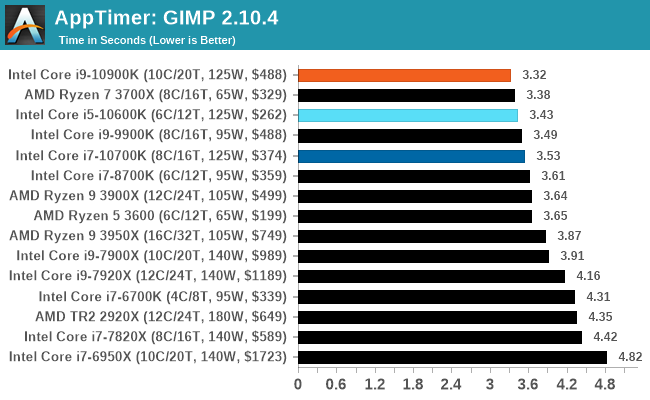
GIMP likes fast single core performance, and so the Core i9 wins here.
Agisoft Photoscan 1.3.3: 2D Image to 3D Model Conversion
One of the ISVs that we have worked with for a number of years is Agisoft, who develop software called PhotoScan that transforms a number of 2D images into a 3D model. This is an important tool in model development and archiving, and relies on a number of single threaded and multi-threaded algorithms to go from one side of the computation to the other.
In our test, we take v1.3.3 of the software with a good sized data set of 84 x 18 megapixel photos and push it through a reasonably fast variant of the algorithms, but is still more stringent than our 2017 test. We report the total time to complete the process.
Agisoft’s Photoscan website can be found here: http://www.agisoft.com/
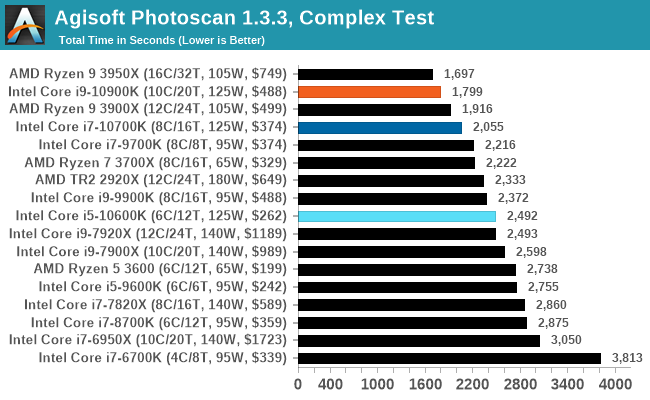
Agisoft is a mix of variable threaded workloads, so a good balanced system works best. Intel's $500 option is faster than AMD's $500 option here, with two fewer cores.
AI Benchmark
One of the longest time requests we’ve had for our benchmark suite is AI-related benchmark, and the folks over at ETH have moved their popular AI Benchmark from mobile over PC. Using Intel’s MKL and Tensorflow 2.1.0, we use version 0.1.2 of the benchmark which tests both training and inference over a variety of different models. You can read the full scope of the benchmark here.
This is one of our new tests in the database, and we are still gaining data for it.
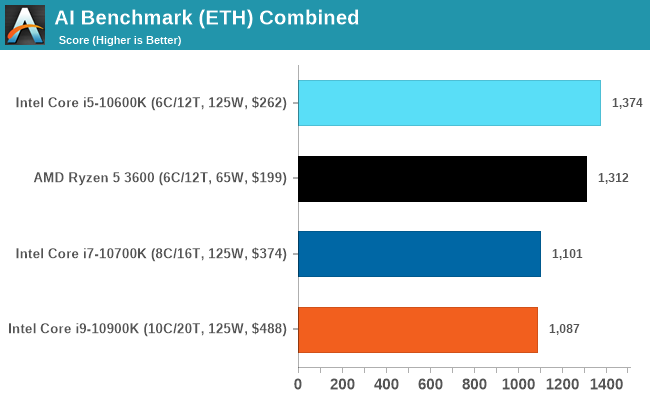
AIBench is a new test here, covering both training and inference. In the breakdown of results, we noticed that the faster processors were actually slower, scoring a lower result. We believe this is down to the lower bandwidth/core afforded by the 10c design against the 6c design.
Accelerated Science Tests
3D Particle Movement v2.1: Brownian Motion
Our 3DPM test is a custom built benchmark designed to simulate six different particle movement algorithms of points in a 3D space. The algorithms were developed as part of my PhD., and while ultimately perform best on a GPU, provide a good idea on how instruction streams are interpreted by different microarchitectures.
A key part of the algorithms is the random number generation – we use relatively fast generation which ends up implementing dependency chains in the code. The upgrade over the naïve first version of this code solved for false sharing in the caches, a major bottleneck. We are also looking at AVX2 and AVX512 versions of this benchmark for future reviews.
For this test, we run a stock particle set over the six algorithms for 20 seconds apiece, with 10 second pauses, and report the total rate of particle movement, in millions of operations (movements) per second. We have a non-AVX version and an AVX version, with the latter implementing AVX512 and AVX2 where possible.
3DPM v2.1 can be downloaded from our server: 3DPMv2.1.rar (13.0 MB)


No real surprises in our 3DPM tests.
y-Cruncher v0.7.6: Microarchitecture Optimized Compute
I’ve known about y-Cruncher for a while, as a tool to help compute various mathematical constants, but it wasn’t until I began talking with its developer, Alex Yee, a researcher from NWU and now software optimization developer, that I realized that he has optimized the software like crazy to get the best performance. Naturally, any simulation that can take 20+ days can benefit from a 1% performance increase! Alex started y-cruncher as a high-school project, but it is now at a state where Alex is keeping it up to date to take advantage of the latest instruction sets before they are even made available in hardware.
For our test we run y-cruncher v0.7.6 through all the different optimized variants of the binary, single threaded and multi-threaded, including the AVX-512 optimized binaries. The test is to calculate 250m digits of Pi, and we use the single threaded and multi-threaded versions of this test.
Users can download y-cruncher from Alex’s website: http://www.numberworld.org/y-cruncher/
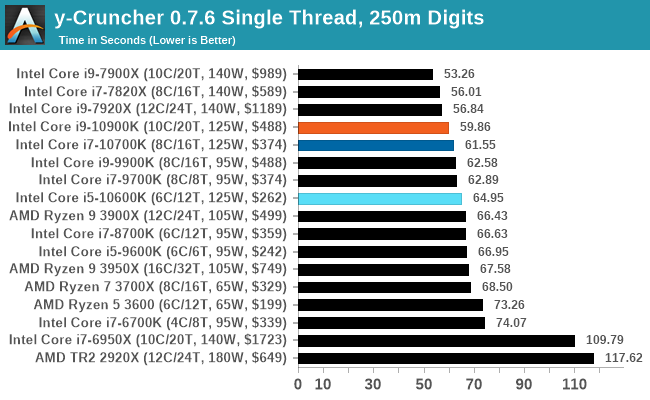
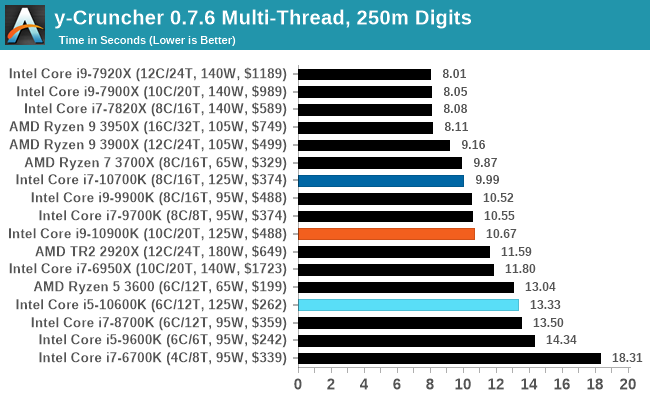
y-Cruncher is another one where the Core i9 performs worse than the Core i7 in the multithreaded test, despite being better on the single threaded test. We again put this down to memory bandwidth. We need to update this test to the latest version of y-Cruncher, which has additional optimizations for Zen 2 processors, but also to increase the digit count in our MT test.











220 Comments
View All Comments
Boshum - Wednesday, May 20, 2020 - link
I generally agree, but I'm not so certain AMD will be in 2nd place within 5 years (from a best CPU architecture point of view). They should be considering the difference in resources, but Intel is so spread out and AMD seems so focused.poohbear - Wednesday, May 20, 2020 - link
OK i'll bite. Why would anyone buy this generation of Intel processors when AMD's is just as powerful and yet more efficient being on 7nm? Especially with Ryzen 4000 coming out this fall.dguy6789 - Wednesday, May 20, 2020 - link
AMD is ahead in a few key areas- price vs performance, total number of cores/threads, power.Intel is still ahead in the per core/per thread area. An Intel 8 core 16 thread will beat an AMD 8 core 16 thread in absolutely everything because of just how high Intel chips can clock to. In short, Intel is a higher performing albeit more expensive option for low thread count workloads.
Boshum - Wednesday, May 20, 2020 - link
I don't think the power and heat are too big a deal until you hit the 8 and 10-core K chips. The people that buy those are enthusiast gamers who want the highest possible FPS in games (whether they are able to perceive it or not, but I am sure they can in certain scenarios). A lot of those ultra-enthusiasts have a lot of fun with overclocking too, and Intel gets more out of that.Ryzen 4000 will undoubtedly be a better overall chip, but Rocket Lake should be coming to the LGA 1200 platform in the not too distant future. It may pass up Ryzen 4000 in gaming for those benchmark enthusiasts. It will be no match for Ryzen 4000 in heavy multi-core scenarios.
gagegfg - Wednesday, May 20, 2020 - link
At the end of the day, AMD continues to have the performance crown at a price premium (3950X).Also, it seems to me a bad ANANTECH policy for many graphics that do not have an AMD equivalent CPU and only put the 3600.
mandoman - Wednesday, May 20, 2020 - link
I can't imaging anyone being the slightest bit concerned about power on the HEDT! It's simply ludicrous to even bring it into the discussion. Frankly the whole emphasis in this review smacks loudly of "tree hugger" philosophy which has no place in the high end computing arena at all.Beany2013 - Wednesday, May 20, 2020 - link
Some of us actually care about good engineering rather than pushing an old, inefficient process node as hard as technically possible.Enjoy dropping an extra £100 just to cool your CPU.
Hxx - Wednesday, May 20, 2020 - link
WHAAT? U think this is not good engineering? this is BALLS engineering, they basically achieved a miracle on the 14nm platform. You are basically standing in front of a miracle. Step back and think about it. A 5 yo technology that competes and beats in many tests the competitor's 7nm process. Yes overall AMD may be the better purchase but again that not what im saying.Just think about that. On top of that they added good overclocking, controlled temps, plenty features, etc . Cant say im impressed with the Z490 platform itself since its the same old z390/70/270/170 with better connectivity but the CPU themselves will make history I mean the 14nm process sure is effing OLD but man what these guys did with this, the refinement it went through to achieve this performance on this OLD tech is amazing in my opinion and for that I applaud them. I want them to hurry up and wrap up Rocket Lake but this is definitely for sure no doubt definitely great engineering.
alufan - Thursday, May 21, 2020 - link
so what exactly do you think would happen if AMD did the same thing threw the power limits out the window and used a 14++++++ node with the extra thermal headroom available with the 3000 series chips, Intel has not released its new process node chips because they cant make them work AMD has and the limitations are simply due to the node size and physics, they have engineered a way round the issue Intel even now is talking about backporting designs it stinks, this is a "new" chip from Intel with more top end period AMD has released 3 nodes in 3 years and has a new version coming up in a few months with a rumored 20% uplift in IPC but lets wait and see, not to mention 5nm is designed and being sampled and 3nm is in design, that is EngineeringHxx - Thursday, May 21, 2020 - link
ROFL AMD? AMD struggles with getting a BIOS right let alone fine tuning a platform ? Nah they are too busy now supposedly giving us a beta bios for the 4xx series and that's a very scary thought given AMD's track record. In case you didn't know, AMD doesn't make their own chips. If tsmc moves to a different node then so will AMD, that's how it works. So yes I applaud TSMC for good engineering, AMD not so much.